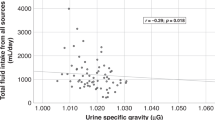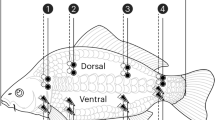Abstract
Background/Objectives:
Little is known on the relationship between obesity and hydration levels in children. This study assessed whether and by which mechanisms hydration status differs between obese and non-obese children.
Subjects/Methods:
Hydration levels of 86 obese and 89 normal weight children (age: 7–11 years) were compared. Hydration was measured as the average free water reserve (FWR=urine output/24 h minus the obligatory urine output [total 24 h excreted solutes/97th percentile of urine osmolality of children with adequate water intake, that is, 830 mOsm/kg]) over 2 days. Three days of weighed dietary and fluid intakes were recorded. Non-parametric tests were used to compare variables that were skewed and to assess which variables correlated with hydration. Variables mediating the different hydration levels of obese and normal weight children were assessed by co-variance analysis.
Results:
Obese children were less hydrated than normal weight peers [FWR=median (IQR): 0.80 (−0.80–2.80) hg/day vs 2.10 (0.10–4.45) hg/day, P<0.02; 32% of obese children vs 20% of non-obese peers had negative FWR, P<0.001]. Body mass index (BMI) z-score (z-BMI) and water intake from fluids correlated with FWR (ρ=−0.18 and 0.45, respectively, both P<0.05). Water intake from fluids completely explained the different hydration between obese and normal weight children [FWR adjusted for water from fluids and z-BMI=2.44 (0.44) hg vs 2.10 (0.50) hg, P=NS; B coefficient of co-variation between FWR (hg/day) and water intake from fluids (hg/day)=0.47, P<0.001].
Conclusions:
Obese children were less hydrated than normal weight ones because, taking into account their z-BMI, they drank less. Future prospective studies are needed to explore possible causal relationships between hydration and obesity.
This is a preview of subscription content, access via your institution
Access options
Subscribe to this journal
Receive 12 print issues and online access
$259.00 per year
only $21.58 per issue
Buy this article
- Purchase on Springer Link
- Instant access to full article PDF
Prices may be subject to local taxes which are calculated during checkout

Similar content being viewed by others
References
Franks PW, Hanson RL, Knowler WC, Sievers ML, Bennett PH, Looker HC . Childhood obesity, other cardiovascular risk factors, and premature death. N Engl J Med 2010; 362: 485–493.
Juonala M, Magnussen CG, Berenson GS, Venn A, Burns TL, Sabin MA et al. Childhood adiposity, adult adiposity, and cardiovascular risk factors. N Engl J Med 2011; 365: 1876–1885.
Maffeis C, Moghetti P, Grezzani A, Clementi M, Gaudino R, Tatò L . Insulin resistance and the persistence of obesity from childhood into adulthood. J Clin Endocrinol Metab 2002; 87: 71–76.
Ambrosini GL, Emmett PM, Northstone K, Howe LD, Tilling K, Jebb SA . Identification of a dietary pattern prospectively associated with increased adiposity during childhood and adolescence. Int J Obes 2012; 36: 1299–1305.
Pérez-Escamilla R, Obbagy JE, Altman JM, Essery EV, McGrane MM, Wong YP et al. Dietary energy density and body weight in adults and children: a systematic review. J Acad Nutr Diet 2012; 112: 671–684.
Stahl A, Kroke A, Bolzenius K, Manz F . Relation between hydration status in children and their dietary profile – results from the DONALD study. Eur J Clin Nutr 2007; 61: 1386–1392.
Cole TJ, Bellizzi MC, Flegal KM, Dietz WH . Establishing a standard definition for child overweight and obesity worldwide: international survey. BMJ 2000; 320: 1240–1243.
Zoppi G, Bressan F, Luciano A . Height and weight reference charts for children aged 2-18 years from Verona, Italy. Eur J Clin Nutr 1996; 50: 462–468.
Maffeis C, Banzato C, Talamini G . Obesity Study Group of the Italian Society of Pediatric Endocrinology and Diabetology. Waist-to-height ratio, a useful index to identify high metabolic risk in overweight children. J Pediatr 2008; 152: 207–213.
Katzmarzyk PT, Shen W, Baxter-Jones A, Bell JD, Butte NF, Demerath EW et al. Adiposity in children and adolescents: correlates and clinical consequences of fat stored in specific body depots. Pediatr Obes 2012; 7: e42–e61.
Tanner JM, Whitehouse RH, Takaishi M . Standards for birth to maturity for height, weight, height and weight velocity: British children 1965. Arch Dis Child 1966; 41: 454–495.
Barreira TV, Staiano AE, Katzmarzyk PT . Validity assessment of a portable bioimpedance scale to estimate body fat percentage in white and African American children and adolescents. Pediatr Obes 2013; 8: e29–e32.
Buzzard M . 24-Hour Dietary Recall and Food Record Method. Nutritional Epidemiology. Walter Willet: Oxford, UK, 1998.
Livingstone MB, Prentice AM, Coward WA, Strain JJ, Black AE, Davies PS et al. Validation of estimates of energy intake by weighed dietary record and diet history in children and adolescents. Am J Clin Nutr 1992; 56: 29–35.
National Institute for the Research in Food and Nutrition Food Composition Tables. EDRA Publ: Milano, Italy, 2007.
Black AE . Critical evaluation of energy intake using the Goldberg cut-off for energy intake: basal metabolic rate. a practical guide to its calculation, use and limitations. Int J Obes 2000; 24: 1119–1130.
Remer T, Neubert A, Maser-Gluth C . Anthropometry-based reference values for 24- h urinary creatinine excretion during growth and their use in endocrine and nutritional research. Am J Clin Nutr 2002; 75: 561–569.
Winberg J . Determination of renal concentration capacity in infants and children without renal disease. Acta Pediatr 1959; 48: 318–328.
Edelmann CM, Barnett HL, Stark H, Boichis H, Rodriguez-Soriano J . A standardized test of renal concentrating capacity in children. Arch Pediatr Adolesc Med 1967; 114: 639–644.
Manz F, Wentz A, Sichert-Hellert W . The most essential nutrient: defining the adequate intake of water. J Pediatr 2002; 141: 587–592.
Sontrop JM, Dixon SN, Garg AX, Buendia-Jimenez I, Dohein O, Huang SH, Clark WF . Association between water intake, chronic kidney disease, and cardiovascular disease: a cross-sectional analysis of NHANES data. Am J Nephrol 2013; 37: 434–442.
Michaud DS, Spiegelman D, Clinton SK, Rimm EB, Curhan GC, Willett WC et al. Fluid intake and the risk of bladder cancer in men. N Eng J Med 1999; 340: 1390–1397.
Masento NA, Golightly M, Field DT, Butler LT, van Reekum CM . Effects of hydration status on cognitive performance and mood. Br J Nutr 2014; 111: 1841–1852.
Li Y, Dai Q, Jackson JC, Zhang J . Overweight is associated with decreased cognitive functioning among school-age children and adolescents. Obesity (Silver Spring) 2008; 16: 1809–1815.
Kavouras SA, Johnson EC, Bougatsas D, Arnaoutis G, Panagiotakos DB, Perrier E et al. Validation of a urine color scale for assessment of urine osmolality in healthy children. Eur J Nutr. epub ahead of print 24 April 2015 PMID: 25905541.
EFSA (European Food Standards Agency). Scientific opinion on dietary reference values for water. EFSA J 2010; 8: 1459.
Bellisle F, Thornton SN, Hébel P, Denizeau M, Tahiri M . A study of fluid intake from beverages in a sample of healthy French children, adolescents and adults. Eur J Clin Nutr 2010; 64: 350–355.
Drewnowski A, Rehm CD, Constant F . Water and beverage consumption among children 4-13y in the United States: analysis of 2005-2010 NHANES data. Nutr J 2013; 12: 85.
Morgan RE . Does consumption of high-fructose corn syrup beverages cause obesity in children? Pediatr Obes 2013; 8: 249–254.
Ozen AE, Bibiloni MD, Pons A, Tur JA . Fluid intake from beverages across age groups: a systematic review. J Hum Nutr Diet 28: 417–442.
Acknowledgements
This work was funded by a grant of the Department of Life and Reproduction Sciences of the University of Verona and partly by a grant from the European Hydration Institute (EHI). The EHI did not directly contribute to the study design, the collection, analysis and interpretation of data or in the writing of the manuscript. We thank Ron Maughan for his helpful comments and suggestions.
Author information
Authors and Affiliations
Corresponding author
Ethics declarations
Competing interests
The authors declare no conflict of interest.
Rights and permissions
About this article
Cite this article
Maffeis, C., Tommasi, M., Tomasselli, F. et al. Fluid intake and hydration status in obese vs normal weight children. Eur J Clin Nutr 70, 560–565 (2016). https://doi.org/10.1038/ejcn.2015.170
Received:
Revised:
Accepted:
Published:
Issue Date:
DOI: https://doi.org/10.1038/ejcn.2015.170
This article is cited by
-
The association between hydration status and total fluid intake in healthy children and adolescents
Pediatric Research (2023)
-
Afternoon urine osmolality is equivalent to 24 h for hydration assessment in healthy children
European Journal of Clinical Nutrition (2020)
-
Factors associated with water consumption among children: a systematic review
International Journal of Behavioral Nutrition and Physical Activity (2019)
-
Water intake and hydration state in children
European Journal of Nutrition (2019)
-
Water intake and urinary hydration biomarkers in children
European Journal of Clinical Nutrition (2017)



